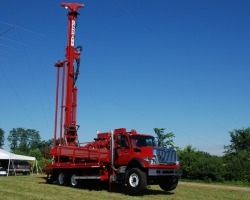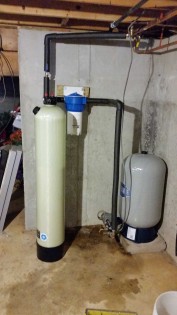 Most wells in Maine use the rotary drilling method, a drill bit is attached to a length of connected drill pipe. The drill bit is made of tough metals such as tungsten, and as the drill is rotated, the bit acts to grind up the rock. The broken pieces (cuttings) are flushed upward and out of the hole by circulating a drilling fluid (sometimes called drilling mud) down through the drill pipe and back to the surface. This drilling fluid also serves to cool and lubricate the drill bit, and by stabilizing the wall of the hole, it can prevent possible cave-in of unstable sands or crumbly rock before the well casing or well screen is installed. As the drill intersects water-bearing rock formations water will flow into the hole. We carefully monitor the depth of water “strikes” and keep a note of the formations in which they occur. In areas of hard rocks we use a well drilling technique that uses compressed air to operate a down-hole air hammer on the end of the drill string that helps to break up the hard rocks. The compressed air also blows the crushed rock fragments out of the hole to the surface along with any water that flows in the well during drilling. In low yielding wells it is sometimes possible to increase yield by using “hydrofrac” techniques. In this process, selected parts of the drilled hole are subjected to great pressure using special tools lowered from the surface. The expected result is that small existing fractures will be enlarged or opened up to allow the well to connect to additional water bearing fractures or fissures. No matter which method of drilling is used, the top part of the well is always lined with a minimum of 20 feet of steel well casing. The diameter of the drilled hole is usually an inch or two wider than the diameter of the casing. The space between the drilled hole and the casing (the annulus) has to be filled to prevent the chance of polluted surface water from migrating downward along the outside of the casing where it might contaminate the aquifer. Most of the space is filled with the fine rock pieces from drilling. A modern water well is much more than a hole in the ground.
Most wells in Maine use the rotary drilling method, a drill bit is attached to a length of connected drill pipe. The drill bit is made of tough metals such as tungsten, and as the drill is rotated, the bit acts to grind up the rock. The broken pieces (cuttings) are flushed upward and out of the hole by circulating a drilling fluid (sometimes called drilling mud) down through the drill pipe and back to the surface. This drilling fluid also serves to cool and lubricate the drill bit, and by stabilizing the wall of the hole, it can prevent possible cave-in of unstable sands or crumbly rock before the well casing or well screen is installed. As the drill intersects water-bearing rock formations water will flow into the hole. We carefully monitor the depth of water “strikes” and keep a note of the formations in which they occur. In areas of hard rocks we use a well drilling technique that uses compressed air to operate a down-hole air hammer on the end of the drill string that helps to break up the hard rocks. The compressed air also blows the crushed rock fragments out of the hole to the surface along with any water that flows in the well during drilling. In low yielding wells it is sometimes possible to increase yield by using “hydrofrac” techniques. In this process, selected parts of the drilled hole are subjected to great pressure using special tools lowered from the surface. The expected result is that small existing fractures will be enlarged or opened up to allow the well to connect to additional water bearing fractures or fissures. No matter which method of drilling is used, the top part of the well is always lined with a minimum of 20 feet of steel well casing. The diameter of the drilled hole is usually an inch or two wider than the diameter of the casing. The space between the drilled hole and the casing (the annulus) has to be filled to prevent the chance of polluted surface water from migrating downward along the outside of the casing where it might contaminate the aquifer. Most of the space is filled with the fine rock pieces from drilling. A modern water well is much more than a hole in the ground.
Clearwater Well Drilling Recommended Flow Rates
Flow Rates: 100 ft = 6 gal/min, 140 ft = 5 gal/min, 180 ft = 4gal/min, 240 ft = 3 gal/min, 320 ft = 2 gal/min, 420 ft = 1 gal/min
Clearwater uses higher flow rates then normal state standards
9 reasons why to use Clearwater Well Drilling
With Clearwater Well Drilling, you get much more than just a company that drills water wells and installs water pumps.
Benefits
- On-Time Scheduling
- Increased Flow rates above state standards
- Proper sizing of water pumps & tanks (This ensures your water needs are met)
- Water Testing (With Clearwater the job does not end with the water pump. We fully chlorinate the well and pump and then take a water sample upon request and send it to the lab for analysis. We then provide a copy for you with any recommendations and pricing on any filtration that might be needed if necessary).
- Upgradable systems (Clearwater offers constant pressure systems for those customers who would like additional water pressure without the fluctuation that accompanies a traditional system).
- Ability to handle and knowledge of water requirements for FHA regulations
- Ability to handle and knowledge of water requirements and pumping systems for houses that require fire sprinkler systems without having to install space consuming holding tanks in the basement.
- Use of materials above industry standards
- Varmint Proof Well caps (Prevents insects or any other critters from getting into the well). The industry standard is just a regular cap.
At Clearwater Well Drilling we are a full-service water company that takes pride in being able to service a job from the beginning to the very end.



